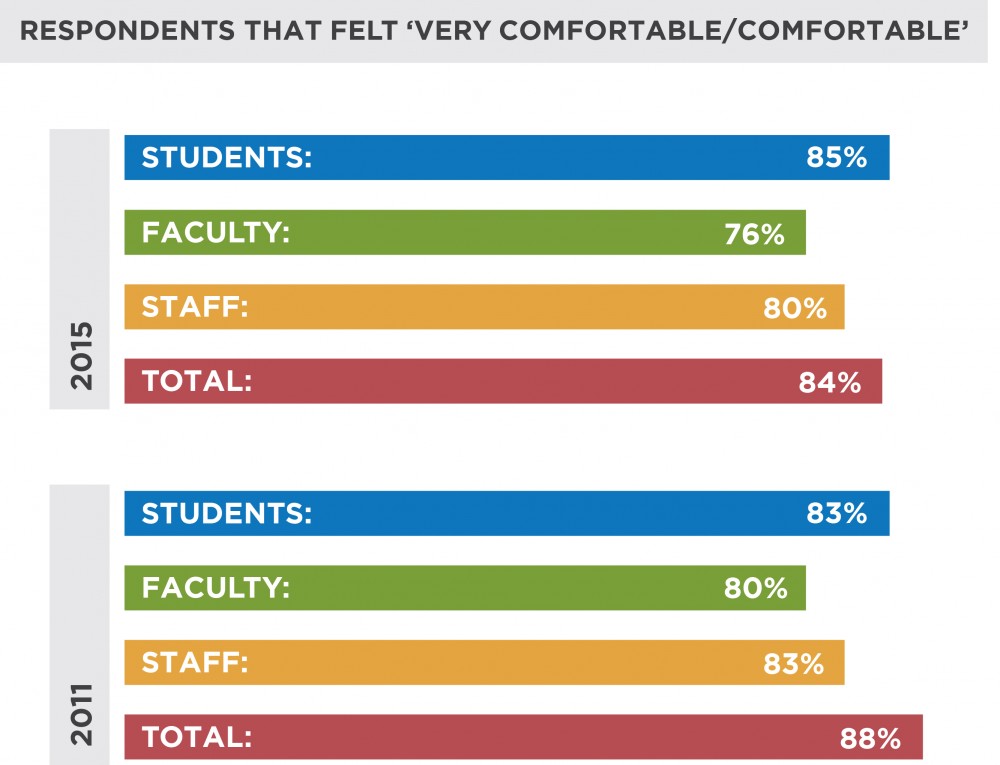Campus Climate Survey results show decrease in faculty, staff comfort at GVSU
Feb 29, 2016
Earlier this year, students, faculty and staff at Grand Valley State University completed the fifth Campus Climate Survey, and the results are in.
The survey, which was last administered in 2011, measured how Lakers perceive the campus atmosphere, with particular emphasis on minority and marginalized populations.
Though not all the data has been analyzed, early findings indicate that while students feel more comfortable on GVSU’s campus than in 2011, the same cannot be said for faculty and staff.
In addition, two groups of students reported more negative feelings about the GVSU campus climate than any others: Students of color and transgender students.
The 2015 iteration of the Campus Climate Survey drew the largest response rate of any of the five surveys since the flagship survey in 1994. Students had the most significant jump in participation, going from 26 percent in 2011 to 40 percent in 2015.
More faculty also completed the survey, with 57 percent participating, compared to 45 percent in 2011. Staff had the highest response rate of any group, as 61 percent completed the survey. Staff also had the highest participation in 2011, with 57 percent completion. These numbers led to a 13 percent increase in campus-wide survey completion, jumping from 29 percent in 2011 to 42 percent this year.
“I think the response rate that we initially got was pretty telling,” said Jesse Bernal, vice president of the Division of Inclusion and Equity. “We had the highest response rate in the history of our surveys. The community wants to be heard.”
Based on preliminary results, campus climate has improved for women, people with disabilities and some members of the LGBT community.
“Unfortunately, the experiences for people of color and our transgender have declined,” Bernal said. “Overall campus climate experiences from 2011 to 2015, there are more negative experiences.”
Though some members of the GVSU community appear to be less content with the campus climate than in 2011, the data shows an overwhelmingly positive experience for most Lakers.
“Data showed that GVSU has a more welcoming, more inclusive, positive climate than nationally,” Bernal said.
When asked to evaluate overall campus climate, 85 percent of students said it was “very comfortable/comfortable.” This is a slight increase of 2 percent from 2011, but the students are the only population that reported an increase.
For faculty and staff, the percentages of individuals who felt the campus climate was comfortable decreased since 2011. There was a 4 percent decrease for faculty, going from 80 percent to 76 percent this year. For staff, that number decreased 3 percent, from 83 percent to 80 percent.
As an institution, 84 percent of Lakers feel the campus climate is comfortable, a decrease of 4 percent since the last survey. This is following a downward trend, as the 2011 total decreased from the 90 percent of Lakers who felt the climate was comfortable in 2005.
“While perception of climate has decreased slightly since 2011 (and) experiences with negative factors have increased with two populations, the commitment to improve actions with climate has increased overall,” Bernal said. “It’s unusual. Usually, you see increases across the board.”
Though the total percentage of Lakers who rank the climate as comfortable has decreased, this may be caused by many factors.
“I think the change in campus demographics (since 2011) is important,” said Andrew Plague, projects assistant for the Division of Inclusion and Equity. “Part of this is the higher response rate.”
One of the concerning areas for Bernal is the negative experiences transgender students are having at GVSU.
“Climate has improved significantly for women since 2011,” Bernal said. It has also improved for LGBQA, but I left out the T. Transgender has a different finding.”
However, Bernal said those reported negative experiences have a silver lining. In past surveys, not enough transgender students participated in the survey to be able to have their voices heard in significant numbers.
“I think that as we build a critical mass of people in terms of people of color, LGBT, specifically transgender, we do have a lot of work to make sure that people that come here feel included and supported,” Plague said. “There’s some work to do. We have some goals to set and a bar to reach.”
The new data will allow the Division of Inclusion and Equity to begin creating subcommittees and focus groups in order to evaluate how the university can implement change in order to create a more welcoming space for individuals who may need more support, like people of color and transgender individuals.
While the data from this year’s survey is still being analyzed, the Division of Inclusion and Equity will hold an open forum on March 2 to discuss the initial results of the survey. The campus-wide meeting will be held from 3 p.m. until 4:30 p.m. in the Pere Marquette Room of the Kirkhof Center. Those who are unable to attend the meeting in person may participate online by going to www.gvsu.edu/mygvsu during the forum.
“The big takeaway is that this is just the start of the conversation,” Bernal said. “We will continue to use the data to create change on campus. We do understand that there are really good examples of exceptionally welcoming and inclusive units on campus, (but) how do we replicate that everywhere? We have a lot to be proud of, but that’s not a consistent experience across campus.”


























